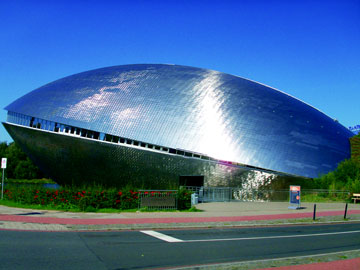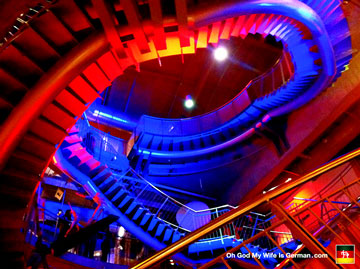Universum Science Center, Bremen, Germany
|

|
| Rising out of the water like a giant fish is the curved shape of the new Universum Science Centre of the University of Bremen, used for science presentations and exhibitions. |
Exclusively Designed for Cosmic Experience
Infotainment is the motto of the new crowd-pullers. Universum Science Center in Bremen is one such example. It is a new type of museum that has emerged, which packages things worth knowing in experiential worlds. The puzzles of the universe unfold at the Universum Science Center. Mankind and nature become fascinating. Not rectangular, not straight, not orthogonally geometrical, Bremen-based architect Thomas Klumpp compares the architecture of the exhibition building, which from the outside reminds of a whale, with life, about the meaning and function of which questions should be asked inside.
The task of setting the stage for things surprising and bizarre, explanatory and entertaining lay in the hands of lighting designer Uwe Belzner, who in each of the experiential rooms has made sure that the lighting scenario specially matched the respective contents. This Center is based on the idea of recognizing ones personality as part of our natural environment. Through the concept of ‘Edutainment’ it combines entertainment and education within a multi-level interior.
Rising out of the water like a giant fish is the curved shape of the new Universum Science Centre of the University of Bremen, used for science presentations and exhibitions. Located at the entrance to the university campus as part of a conference complex, the centre’s distinctive, expressive form marks it out as a building for special purposes. The Science Center offers more than 250 exhibits and experimentation stations, spatial installations and media. Science itself becomes a highly intensive and memorable experience for each visitor.
Stainless Steel Shingles
When it comes to the appearance of the striking Science Center building, interpretations differ considerably. Architect Thomas Klumpp has not only succeeded in lighting a firework of associations with his design, but also in taking the idea of a science center to the outside of the building itself. In 2000 the Universum was built, following his design, using 6, 000 cubic metres of concrete, countless prefabricated parts, steel girders weighing several tons and various wooden structures. About 40,000 stainless steel shingles cover the outside of the building.
The scale-like skin of the building, gleaming in silvery stainless steel, enhances the association with a fish. Some 35,000 stainless steel shingles make up the roofing, laid on a substructure of glued-laminated timber, sandwich elements and waterproof membrane. Each shingle, a rhomboid measuring 40 x 40 cm, is bent to shape on two sides and screwed at four points. Stainless steel stays give added security. The stainless steel 'scales' were made in left-hand and right-hand versions, to fit the two sides of the 'fish'. This was necessary to maintain even colour effects along each side, as the fine satin finish reflected differently when the shingles were turned around. Above a pitch of 17° – not visible from the ground – the shingle covering is replaced by stainless steel standing-seam roofing. Rainwater is fed into the lake around the building, via the lower lip of the fish’s mouth.
 |
The spectacular, futuristic building containing the Universum Bremen Science Center looks like a silver whale from the outside. Inside, you learn all about the fascinating world of science by experimenting and interacting with 250 hands-on installations. The approx. 4,000m² permanent exhibition is themed on three exciting 'expeditions', exploring Man, Earth and the Cosmos. Many of the phenomena that you experience with your own body are as an exciting as any cinema thriller: the pitch-black maze, for example, where you have to rely on your sense of touch to feel your way around or a virtual trip to the bottom of the sea in a submersible. The rowing skeleton Freddy shows you what happens to your bones when you exercise. In the earthquake room, the walls shake violently at the push of a button. Expedition Cosmos ventures to the stars and explores the smallest components of matter.
In the Science center at Universum Bremen, children, adolescents & adults can go and thrilling journey through the fantastic realms of mankind, earth and cosmos. Different scientific phenomena are explored using all senses like feeling vibrations of a sound running through their entire body, play with their own weight on a beam scale, feel the shape of a room in complete darkness, smell unknown aroma.
The three themed areas encourage visitors to research and discover things for themselves, which is why they are called “expeditions”. Short experimentation instructions and explanations aid visitors with their learning experience, and unlike many other Science Centers, the themed areas in Bremen’s Science Center have a beginning and an end. Expedition Mensch (Expedition Mankind), for example, begins with a fascinating time-lapse film to illustrate the development of a foetus. Afterwards visitors are introduced to the human senses, and are made to experience fear by standing beneath a huge stone which is only held in place by two thin wire ropes.
Experience the power of nature on the earthquake sofa
Expedition Erde (Expedition Earth) begins in the centre of the earth, where visitors learn about such phenomena as magnetism. They then climb a mining ladder to reach higher layers of the earth and learn more about earthquakes and volcanism. To find out, on the earthquake sofa brave visitors can experience at the push of a button the strengths of three different earthquakes that have actually taken place – in San Francisco, Albstadt and Izmit, whilst an illuminated board illustrates the way in which continental plates shift – the cause of earthquakes and volcanism. Next the focus of the expedition shifts to the earth’s surface and the forces of nature that play out upon it and are responsible for the appearance of our blue planet. Which paths do water flows take, and how are river deltas formed? How does a tornado come into being? Visitors also learn about different structures on the earth’s surface.
A trip to Stars
Expedition Kosmos (Expedition Cosmos) starts with a trip through the universe. Fascinating photographs taken by the Hubble Space Telescope and a replica night sky transport enthrall visitors into other dimensions. The focus then shifts to colour and light. Is it really possible to jump over one’s own shadow? Yes, it is – in the frozen shadows room, where shadows can be captured for seconds at a time. Elsewhere colours can be mixed on a six-foot revolving mandala, while a ball floats in mid-air. In the Science Center everything is clean and above board, and visitors learn about scientific laws whilst having fun.
The Milky Way
What’s it like to walk through coloured rooms? Can I be the main star in a film about volcano researchers? In January 2007 a children’s area was opened on the ground floor, where the youngest visitors can sort out stones, shells and buttons, build imaginative structures with blocks of wood, walk along dream paths and create films. This experience-based area, called the Milchstraße, is specially designed for children between 3 and 8 years, and features more than 25 exhibits covering an area of 200m2.
Another place in which to experiment in the Science Center is the ForscherAtelier (Researchers’ Workshop) on the third floor. The 70 m2 room can be booked by groups of children and adults for experiments, lectures and workshops. In addition to the permanent exhibition, the Science Center also organizes a number of special events. Courageous gourmets, for example, can enjoy an exclusive three-course menu in complete darkness. The Science Center also plays host to external events focusing on health-related matters, for example.
Some Light on Lighting
According to Uwe Belzner, the lighting designer, the challenge in the lighting design of the Universum Science Center in Bremen lay in setting the stage on 4,000 square metres of exhibition area for a variety of sections in accordance with the respective subjects. In addition, the lighting system had to be flexible to allow for future developments of the Universum. Despite the theatrically designed ambience of the Science Center, financial considerations led to the adoption solely of luminaires currently used in the architectural field. The luminaires were placed on about 250 expanded metal grids suspended from the ceiling.
In order to give the visitors some orientation in an exhibition and this at times almost resembles a labyrinth and in order to make it possible to experience from the inside the external form of the building reminding of a whale, the skin pulses in a subtle way. To do so the edges of the storey ceilings are fitted with two rows of free-standing batten luminaires, which are individually coloured and controlled. Coloured LED lighting strips are employed as a guiding system for the three exhibition areas ‘Mankind’, ‘The Earth’ and ‘Cosmos’, and also to set the scene of the central multi-functional area.
References:
http://www.germany.travel/en/specials/family-attractions/universum-bremen-science-center.html
http://www.iar.unicamp.br/lab/luz/ld/Arquitetural/diversos/light_for_art_and_culture.pdf
http://www.universum-bremen.de/research-in-the-science-center/?lang=en
http://www.euro-inox.org/htm/p_6_EN.html